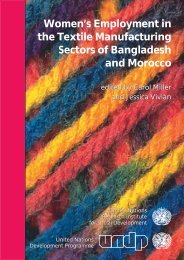Beyond Pragmatism: Appraising UN-Business Partnerships
Beyond Pragmatism: Appraising UN-Business Partnerships
Beyond Pragmatism: Appraising UN-Business Partnerships
You also want an ePaper? Increase the reach of your titles
YUMPU automatically turns print PDFs into web optimized ePapers that Google loves.
<strong>UN</strong>RISD PROGRAMME ON MARKETS, BUSINESS AND REGULATION<br />
PAPER NUMBER 1<br />
erosion of the political framework for <strong>UN</strong>–business partnerships established in various <strong>UN</strong><br />
General Assembly resolutions. To avert this situation, a more active, critical intellectual culture<br />
developed in and around <strong>UN</strong> partnership activities is needed in order to make its own<br />
contribution to transforming the <strong>UN</strong> “into a more effective partnership player”. 47 This itself will<br />
also depend on systematic in-depth monitoring, impact assessment and wider evaluation of<br />
<strong>UN</strong>–business partnerships. Furthermore, as the Organisation for Economic Co-operation and<br />
Development (OECD) emphasizes, “An important reason to evaluate partnerships is to assess<br />
their value-added. … Evaluations need to demonstrate convincingly that partnerships are an<br />
alternative or complementary approach to traditional policy-making and implementation”<br />
(2006:11).<br />
3. Where is the Evidence?<br />
Monitoring, impact assessment and evaluation<br />
PPP practitioners from the business world included the following among the guidelines they<br />
considered essential for the success of partnerships: “create a win-win partnership with<br />
measurable benefits and results…agree on clear targets…and conduct consistent and long-term<br />
monitoring and evaluation studies to evaluate PPP outcomes” (WEF 2006:41, box 10). However,<br />
in the case of <strong>UN</strong>–BPs, monitoring and evaluation have only recently been put on the agenda:<br />
the 2006 <strong>UN</strong> General Assembly Resolution 60/215 requested the Secretary General “in<br />
consultation with Member States, to promote, within existing resources, impact assessment<br />
mechanisms, taking into account the best tools available, in order to enable effective<br />
management, ensure accountability, and facilitate effective learning from both successes and<br />
failures” (<strong>UN</strong> General Assembly 2006:paragraph 13).<br />
The <strong>UN</strong> Secretary General’s report on <strong>Partnerships</strong> for Sustainable Development (United<br />
Nations Economic and Social Council, Commission on Sustainable Development 2006),<br />
provides a synthesis of various aspects of the current situation as reported by the partnerships<br />
themselves, and states that “[m]any partnerships have reported on the successes of ongoing<br />
pilot projects and research studies at the regional and country levels”. But no evidence is<br />
provided regarding the existence or otherwise of detailed evaluation and impact assessment<br />
studies. The results of a recent OECD survey aiming to examine evaluations of <strong>UN</strong>CSD Type II<br />
environmental partnerships present a dismal picture. Of the 101 partnerships included in the<br />
survey, 34 responded to the questionnaire and, of these responses, two were considered<br />
insufficiently complete to be included in the analysis. Only 28 per cent of the remaining 32<br />
partnership responses indicated that they had completed an evaluation (OECD 2006:11).<br />
The burgeoning <strong>UN</strong> literature on partnerships presents numerous “showcase” examples<br />
suggesting success, though little robust evidence, if any, is presented in support. In the section<br />
“What we know and are learning about partnerships” in its publication, Partnering for<br />
Development, <strong>UN</strong>DP relates that “There are some descriptions of individual partnerships but<br />
when it comes to a more comprehensive description of a larger number of cases based on<br />
comparable information the information is limited” (<strong>UN</strong>DP 2006:54). The overview of <strong>UN</strong>–<br />
business partnerships conducted by Witte and Reinicke (2005:44, 50) finds that impact<br />
assessment is rare and is not conducted consistently. The Food and Agriculture Organization of<br />
the United Nations (FAO) and the World Bank Group, on the other hand, are considered more<br />
advanced than other <strong>UN</strong> agencies in developing partnership impact assessment frameworks.<br />
The United Nations Industrial Development Organization’s (<strong>UN</strong>IDO) Automotive Partnership<br />
involving Fiat (an example of harnessing markets for development by providing assistance to<br />
47<br />
The final report relating to the May 2005 meeting of the <strong>UN</strong> System of Private Sector Focal Points included the proposition that<br />
“Existing institutional incentive structures that emphasize avoiding risks and safeguarding the status quo need to be adapted to<br />
better support partnerships”, and also the recommendation that “In the long run, such challenges must be addressed on a<br />
comprehensive, organizational scale, in order to transform the United Nations into a more effective partnership player” (United<br />
Nations System Private Sector Focal Points Meeting 2005:1, 2).<br />
20
















